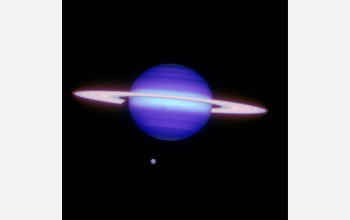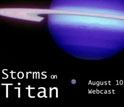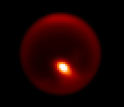News Release 09-150
Storm Clouds Over Titan
Ground-based telescope captures first visual images of storm clouds over the tropics of Saturn's largest moon

Gemini North infrared image of Saturn and Titan.
August 12, 2009
View a video of astronomers Henry Roe and Mike Brown discussing recently announced observations of storm clouds in the tropics of Titan.
This material is available primarily for archival purposes. Telephone numbers or other contact information may be out of date; please see current contact information at media contacts.
Taking advantage of advanced techniques to correct distortions caused by Earth's atmosphere, astronomers used the NSF-supported Gemini Observatory to capture the first images of clouds over the tropics of Titan, Saturn's largest moon.
The images clarify a long-standing mystery linking Titan's weather and surface features, helping astronomers better understand the moon of Saturn, viewed by some scientists as an analog to Earth when our planet was young.
The effort also served as the latest demonstration of adaptive optics, which use deformable mirrors to enable NSF's suite of ground-based telescopes to capture images that in some cases exceed the resolution of images captured by space-based counterparts.
Emily Schaller from the University of Hawai'i, Henry Roe from Lowell Observatory, and Tapio Schneider and Mike Brown, both of Caltech, reported their findings in the Aug. 13, 2009, issue of Nature.
"Adaptive optics are helping our ground-based telescopes accomplish feats that have until now been capable only with telescopes in space," said Brian Patten, a program director in NSF's Astronomy Division. "Now, we can remove the affects of the atmosphere, capturing images that in some cases exceed the resolution of those captured by space-based telescopes. Investments in adaptive optics technology are really starting to pay off."
On Titan, clouds of light hydrocarbons, not water, occasionally emerge in the frigid, dense atmosphere, mainly clustering near the poles, where they feed scattered methane lakes below.
Closer to the moon's equator, clouds are rare, and the surface is more similar to an arid, wind-swept terrain on Earth. Observations by space probes suggest evidence for liquid-carved terrain in the tropics, but the cause has been a mystery.
Regular monitoring of Titan's infrared spectrum suggests clouds increased dramatically in 1995 and 2004, inspiring astronomers to watch closely for the next brightening, an indicator of storms that could be imaged from Earth.
Schaller and her colleagues used NASA's Infrared Telescope Facility (IRTF), situated on Hawaii's Mauna Kea, to monitor Titan on 138 nights over a period of two years, and on April 13, 2008, the team saw a tell-tale brightening.
The researchers then turned to the NSF-supported Gemini North telescope, an 8-meter telescope also located on Mauna Kea, to capture the extremely high-resolution infrared snapshots of Titan's cloud cover, including the first storms ever observed in the moon's tropics.
The team suggests that the storms may yield precipitation capable of feeding the apparently liquid-carved channels on the planet's surface, and also influenced weather patterns throughout the moon's atmosphere for several weeks.
Read more in the Gemini press release at http://www.gemini.edu/pio/pr2009-5.php, the Lowell Observatory press release at http://www.lowell.edu/media/releases.php, the University of Hawaii press release at http://www.ifa.hawaii.edu/info/press-releases/SchallerTitanAug09/ and the Caltech release at http://media.caltech.edu/press_releases/13282.
-NSF-
-
View Video
Henry Roe and Mike Brown discuss recently announced observations of Titan's storm clouds.
Credit and Larger Version -
Gemini North adaptive optics image of Titan showing storm feature.
Credit and Larger Version
Media Contacts
Joshua Chamot, NSF, (703) 292-7730, email: jchamot@nsf.gov
Steele Wotkyns, Lowell Observatory, (928) 233-3232, email: steele@lowell.edu
Peter Michaud, Gemini Observatory, (808) 974-2510, email: pmichaud@gemini.edu
Jon Weiner, California Institute of Technology, (626) 395-3226, email: jrweiner@caltech.edu
Louise Good, University of Hawaii Institute for Astronomy, (808) 956-9403, email: good@ifa.hawaii.edu
Program Contacts
Nigel A. Sharp, NSF, (703) 292-4905, email: nsharp@nsf.gov
Brian M Patten, NSF, (703) 292-4910, email: bpatten@nsf.gov
Principal Investigators
Mike Brown, California Institute of Technology, (626) 395-8423, email: mbrown@caltech.edu
Co-Investigators
Henry Roe, Lowell Observatory, (928) 233-3218, email: hroe@lowell.edu
Emily Schaller, University of Arizona, (386) 846 4739, email: schaller@ifa.hawaii.edu
Tapio Schneider, California Institute of Technology, (626) 395-6143, email: tapio@gps.caltech.edu
Related Websites
Gemini Observatory: http://www.gemini.edu
The U.S. National Science Foundation propels the nation forward by advancing fundamental research in all fields of science and engineering. NSF supports research and people by providing facilities, instruments and funding to support their ingenuity and sustain the U.S. as a global leader in research and innovation. With a fiscal year 2023 budget of $9.5 billion, NSF funds reach all 50 states through grants to nearly 2,000 colleges, universities and institutions. Each year, NSF receives more than 40,000 competitive proposals and makes about 11,000 new awards. Those awards include support for cooperative research with industry, Arctic and Antarctic research and operations, and U.S. participation in international scientific efforts.
Connect with us online
NSF website: nsf.gov
NSF News: nsf.gov/news
For News Media: nsf.gov/news/newsroom
Statistics: nsf.gov/statistics/
Awards database: nsf.gov/awardsearch/
Follow us on social
Twitter: twitter.com/NSF
Facebook: facebook.com/US.NSF
Instagram: instagram.com/nsfgov


